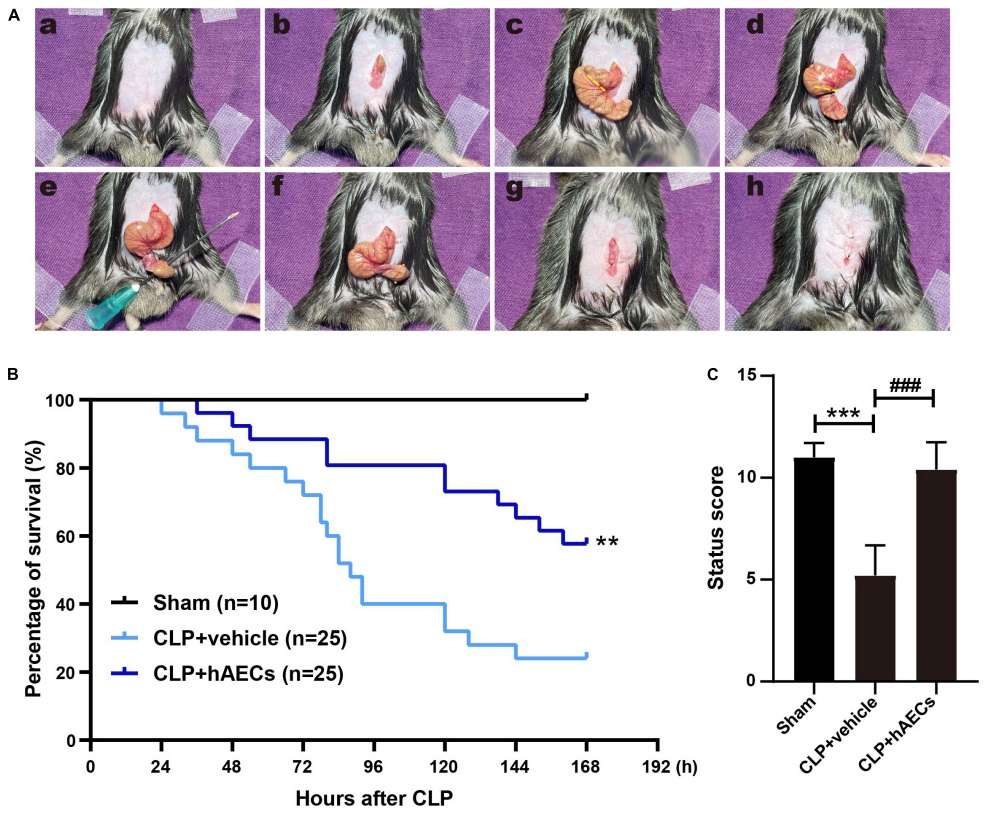Cecum Ligation & Puncture (CLP) induced Sepsis Model
Rodent disease models are widely used for a broad range of project objectives, which involve investigation of pathological process and mechanism of disease, pre-clinical tests of potential therapeutic agents, etc. At Creative Biolabs, you will find the most comprehensive services at the most favorable prices.
Cecum Ligation and Puncture (CLP)-Induced Sepsis Model
Sepsis is a serious medical condition characterized by dysregulated systemic inflammatory responses followed by immunosuppression, which remains a major challenge for scientists and clinicians. Thus, deep investigation into the pathogenic mechanism of this disease is urgently required to promote the development of novel and more effective therapeutic agents. To study the pathophysiology of sepsis, diverse animal models have been developed, among which, polymicrobial sepsis induced by cecal ligation and puncture (CLP) is the most widely used model because it closely resembles the progression and characteristics of human sepsis. Specifically, CLP-induced rodent sepsis model display disease patterns with typical signs of sepsis or septic shock, such as hypothermia, tachycardia, and tachypnea. It is generally accepted that CLP reflects clinical reality more accurately than previous techniques, such as injection of endotoxin or even purified bacteria into rodents.
 Fig. 1 Establishment of septic mouse model and the efficacy evaluation of human amnion epithelial cells (hAECs) on cecal ligation and puncture (CLP) mice1
Fig. 1 Establishment of septic mouse model and the efficacy evaluation of human amnion epithelial cells (hAECs) on cecal ligation and puncture (CLP) mice1
Advantages of Cecum Ligation and Puncture (CLP) Model
The cecal ligation and puncture (CLP) method is a commonly used and readily acceptable procedure for modeling sepsis in vivo for its advantages over the other sepsis models.
Firstly, compared to other models, CLP provides a better representation of the complexity of human sepsis. CLP features ligation below the ileocecal valve after midline laparotomy, followed by needle puncture of the cecum. As the cecum is full of bacteria, its puncture results in polymicrobial peritonitis, translocation of bacteria into the bloodstream (bacteremia), septic shock, multi-organ dysfunction and, finally, death.
Secondly, the pathogens of CLP are endogenous, therefore mimicking traumatic injury leading to peritonitis in humans. What's more, CLP technique meets many of the essential criteria that are required in a potent septic model, it is inexpensive to prepare, technically straightforward and so on. Furthermore, sepsis is highly versatile in adapting to a range of severity and testing objectives.
Creative Biolabs provides such assessments as:
- Clinical Observations
- PK/PD Blood Collections
- Ear Thickness
- Biomarker Analysis
- Histological Observations
- Immunohistochemistry
Meanwhile, in order to meet our customers' specific requirements and their various research objectives, Creative Biolabs also offers other rodent inflammatory & immunological disease models listed as follows that you may be interested in:
- Carrageenan Air Pouch Model
- Carrageenan-Induced Paw Edema Model
- Imiquimod (IMQ)-Induced Psoriasis Rodent Model
- Chemical-Induced Rodent Contact Hypersensitivity Model
- Passive Cutaneous Anaphylaxis (PCA) Model
- Delayed Type Hypersensitivity (DTH) Rodent Model
- Adjuvant-Induced Arthritis (AIA) Rodent Model
- Collagen-Induced Arthritis (CIA) Rodent Model
- Collagen Antibody-Induced Arthritis (CAIA) Model
- LPS-Induced Rodent Sepsis Model
- Spontaneous Systemic Lupus Erythematosus (SLE) Mouse Models
- Induced Models of Systemic Lupus Erythematosus
At Creative Biolabs, we have a group of seasoned experts who are not only specialized in animal surgery to establish an optimal animal model but also experienced in data interpretation. With our rich experiences and cutting-edge techniques, Creative Biolabs is confident to provide you with the first-class services to meet your exact research needs. Contact us or send us an inquiry for more detailed information or a formal quote.
Reference
- Chi, Dongxuan et al. "Human Amnion Epithelial Cells and Their Derived Exosomes Alleviate Sepsis-Associated Acute Kidney Injury via Mitigating Endothelial Dysfunction." Frontiers in medicine vol. 9 829606. 24 Mar. 2022, doi:10.3389/fmed.2022.829606. Distributed under Open Access license CC BY 4.0, without modification.
For Research Use Only.
